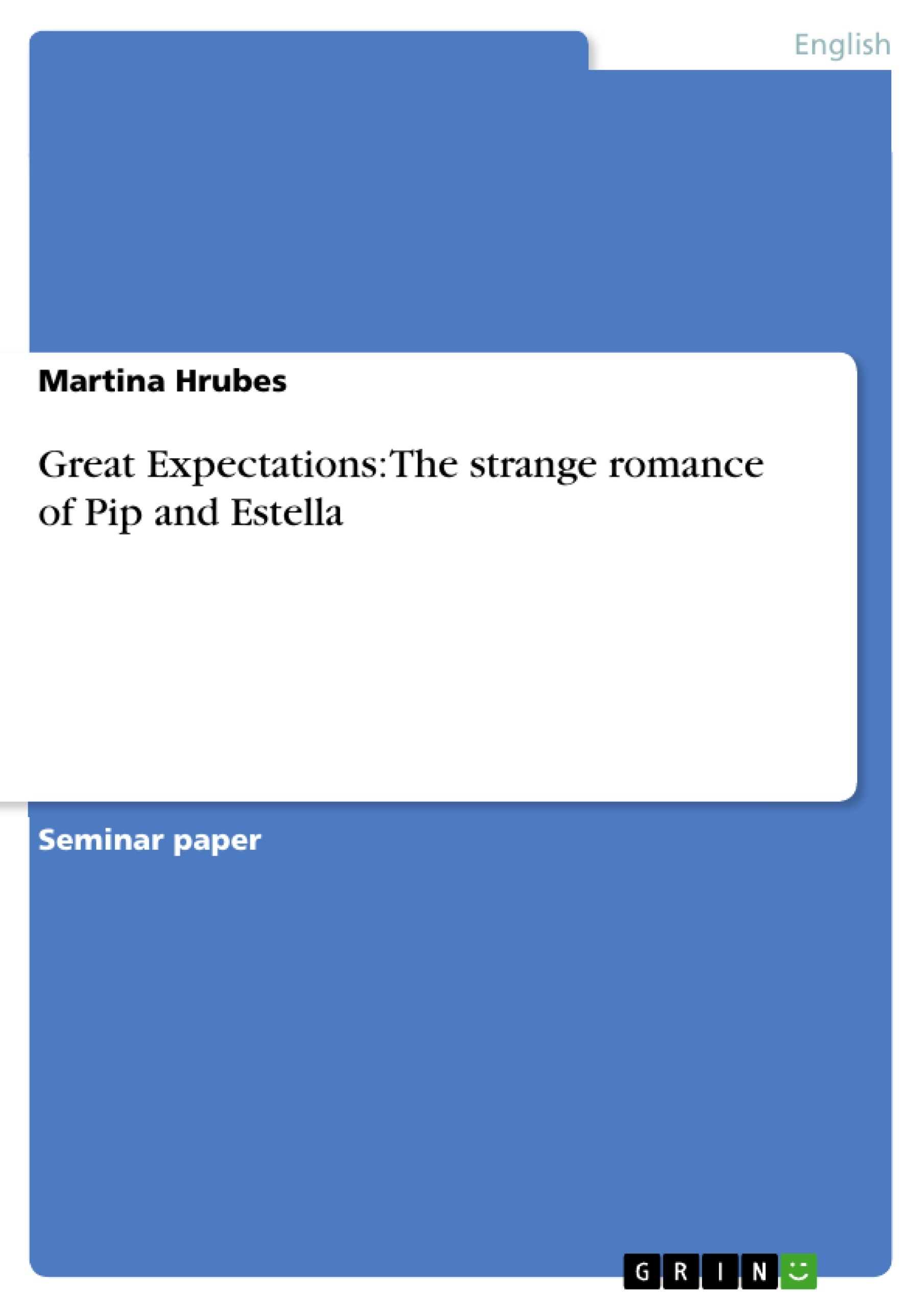Introduction
Pip’s love for the cold- hearted beauty Estella is one of the main themes of Dickens’ Great Expectations and Pip’s main motivation for becoming a gentleman. Throughout the novel Estella seems ever present even when she is miles away. His expectations and aspirations are all linked in some way to his desire for her. Pip’s obsession with Estella is somewhat confusing for today’s readers, since this relationship is clearly one-sided and “[…] against reason, […] against peace, against hope, against happiness, against all discouragement that could be.”1 (S. 229) In his essay I will describe the nature of their relationship. It is going to analyse what it is that attracts Pip to Estella. This means we are going to discuss if Pip’s feelings towards Estella are, at all, of a romantic nature, or if there are other forced at work. I will further show that social and economic aspects play a vital role in their relationship. We are thus going to have a closer look at the background and the upbringing of both characters, in order to clarify in how far the factors that I have mentioned above determine Pip and Estella’s relationship. Lastly I will compare the two endings and see how the conflict between Pip’s naïve aspirations and the somewhat less romantic reality is resolved in each.
Table of Contents
- Introduction
- The significance of Estella's and Pip's backgrounds
- Estella: object of other people's plans
- Pip: helpless victim or self-deceiver?
- The nature of Pip's and Estella's relationship
- The significance of the two endings
Objectives and Key Themes
This essay analyzes the complex relationship between Pip and Estella in Charles Dickens' Great Expectations, focusing on the factors that shape their connection and its impact on Pip's development. It examines the social and economic aspects influencing their interactions, exploring the extent to which their backgrounds determine their relationship.
- The manipulative influence of Miss Havisham on Estella's development.
- The nature of Pip's obsession with Estella – is it romantic love or something else?
- The roles of social class and economic aspirations in shaping Pip and Estella's relationship.
- The contrast between Pip's idealized vision of Estella and the reality of their connection.
- The impact of their respective upbringings on their personalities and interactions.
Chapter Summaries
Introduction: This introductory chapter sets the stage for the essay's analysis of Pip and Estella's relationship in Dickens' Great Expectations. It establishes Pip's love for Estella as a central theme and the driving force behind his ambition to become a gentleman. The introduction highlights the one-sided and seemingly irrational nature of Pip's affection, questioning whether it's purely romantic or influenced by other factors. It outlines the essay's aim to explore the nature of their relationship, investigating the social and economic aspects at play, and comparing the novel's two endings to understand how the conflict between Pip's aspirations and reality is resolved.
The significance of Estella's and Pip's backgrounds: This chapter delves into the backgrounds of Estella and Pip, exploring how their upbringings shape their personalities and influence their relationship. Estella's upbringing, marked by Miss Havisham's manipulative influence and her own vengeful biological mother, creates a woman devoid of genuine emotion. Miss Havisham uses Estella as an instrument of revenge, shaping her into a cold and heartless individual. In contrast, Pip's upbringing is characterized by hardship and a lack of emotional support, influencing his vulnerability and susceptibility to Estella's allure. The chapter explores how these contrasting backgrounds contribute to the dynamics of their complex relationship.
Keywords
Great Expectations, Charles Dickens, Pip, Estella, Miss Havisham, social class, romantic obsession, unrequited love, economic aspiration, revenge, manipulative relationships, childhood trauma.
Great Expectations: Pip and Estella - A Detailed Analysis
What is the main focus of this essay?
This essay analyzes the complex relationship between Pip and Estella in Charles Dickens' Great Expectations. It examines how their backgrounds, social and economic circumstances, and personal characteristics shape their connection and impact Pip's development.
What are the key themes explored in the essay?
Key themes include Miss Havisham's manipulative influence on Estella, the nature of Pip's obsession with Estella (is it romantic love or something else?), the roles of social class and economic aspirations, the contrast between Pip's idealized vision of Estella and reality, and the impact of their upbringings on their personalities and interactions.
What aspects of Pip and Estella's backgrounds are examined?
The essay delves into Estella's upbringing, highlighting Miss Havisham's manipulation and Estella's vengeful mother, which contribute to her cold and heartless demeanor. Pip's background, characterized by hardship and lack of emotional support, is contrasted, explaining his vulnerability and attraction to Estella. The essay explores how these contrasting backgrounds influence their relationship dynamics.
What is the significance of the two endings of the novel in this analysis?
The essay considers the two endings of Great Expectations to understand how the conflict between Pip's aspirations and reality is resolved within the context of his relationship with Estella.
What is the structure of the essay as previewed in this HTML?
The preview includes a table of contents, objectives and key themes, chapter summaries (specifically the introduction and the chapter on Pip and Estella's backgrounds), and keywords. It provides a comprehensive overview of the essay's content and arguments.
What are the keywords associated with this essay?
Keywords include: Great Expectations, Charles Dickens, Pip, Estella, Miss Havisham, social class, romantic obsession, unrequited love, economic aspiration, revenge, manipulative relationships, and childhood trauma.
What is the purpose of the introduction chapter?
The introduction establishes Pip's love for Estella as the central theme and the driving force behind his ambition. It highlights the one-sided and potentially non-romantic nature of his affection and outlines the essay's aim to explore the complexities of their relationship, considering social and economic factors and comparing the novel's two endings.
- Quote paper
- Martina Hrubes (Author), 2003, Great Expectations: The strange romance of Pip and Estella, Munich, GRIN Verlag, https://www.grin.com/document/36426




